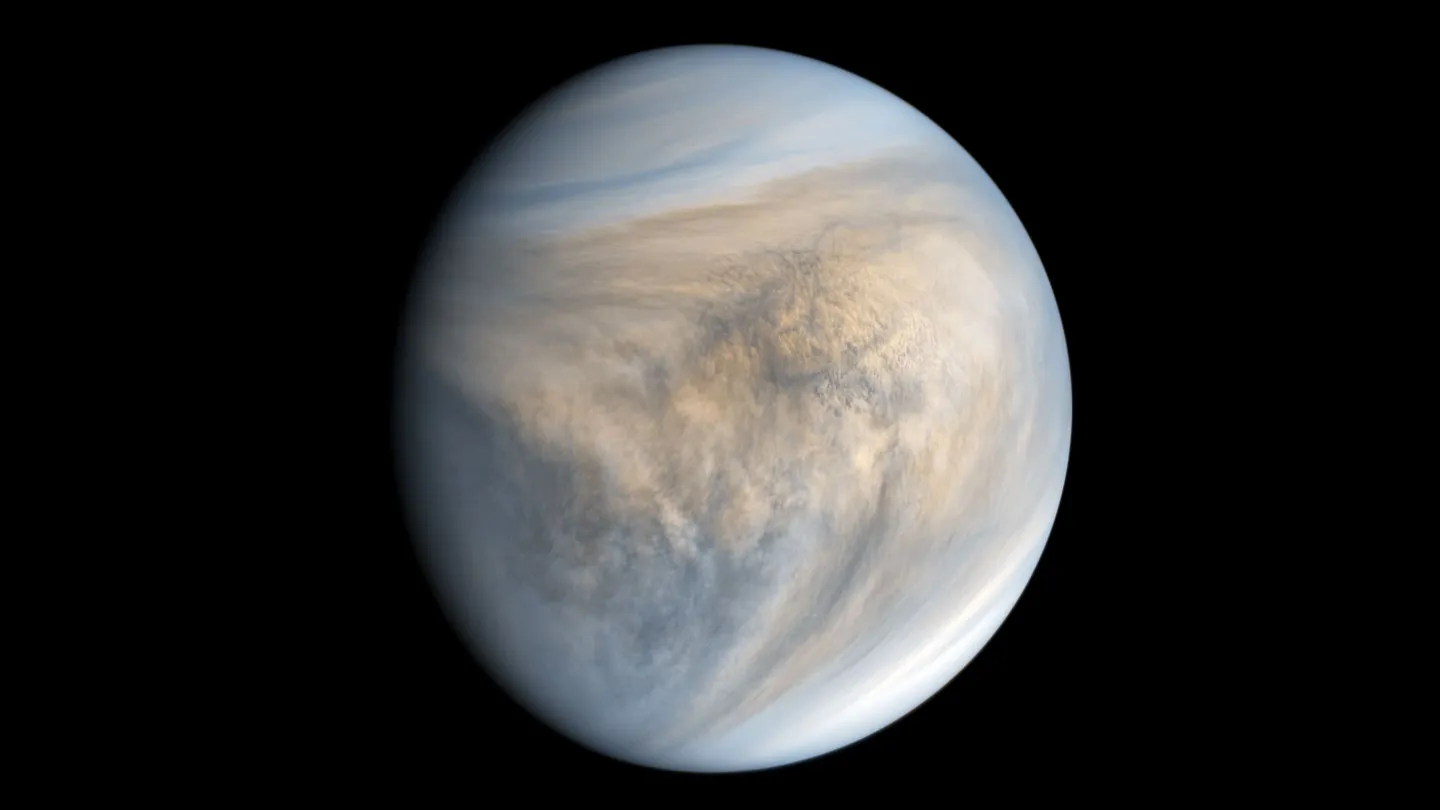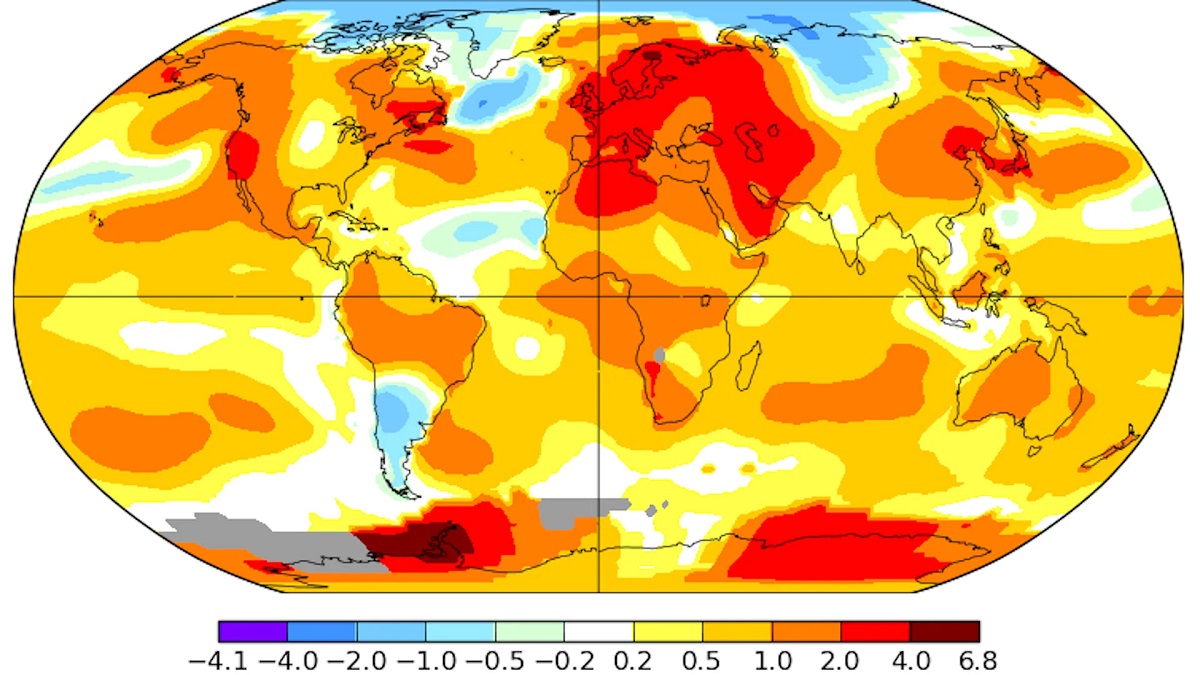Home>Weather and Climate>The Average Temperature Of Venus: Exploring The Climate Of Earth’s Twin


Weather and Climate
The Average Temperature Of Venus: Exploring The Climate Of Earth’s Twin
Published: April 14, 2024
Discover the weather and climate of Venus, Earth's twin, including its average temperature and climate conditions. Explore the similarities and differences between the two planets.
(Many of the links in this article redirect to a specific reviewed product. Your purchase of these products through affiliate links helps to generate commission for Temperatures.com, at no extra cost. Learn more)
Table of Contents
Introduction
Venus, often referred to as Earth's twin, is a fascinating planet that has captivated the curiosity of scientists and space enthusiasts for centuries. While it shares some similarities with our home planet, such as a comparable size and gravity, Venus is shrouded in an enigmatic veil of extreme conditions that set it apart from Earth in dramatic ways. One of the most striking differentiators is the planet's scorching surface temperature, which far exceeds that of any other planet in our solar system. In this article, we will delve into the average temperature of Venus and explore the unique climate that defines this celestial neighbor.
As we embark on this exploration, we will unravel the mysteries of Venus's atmosphere, which plays a pivotal role in shaping the planet's climate. By understanding the composition and dynamics of the Venusian atmosphere, we can gain valuable insights into the factors driving the extreme temperatures experienced on the planet's surface. Additionally, we will compare these conditions to those of Earth, providing a compelling contrast that highlights the remarkable diversity of planetary environments within our solar system.
Moreover, we will examine potential explanations for the extreme heat that envelops Venus, drawing upon scientific theories and observations to shed light on this extraordinary phenomenon. By delving into the complexities of Venus's climate, we can deepen our appreciation for the intricate interplay of planetary processes and the awe-inspiring diversity of worlds beyond our own.
Through this exploration, we aim to foster a deeper understanding of Venus's climate and the factors that contribute to its staggering surface temperatures. By unraveling the mysteries of this captivating planet, we can expand our horizons and gain a newfound appreciation for the dynamic tapestry of celestial bodies that populate our solar system. Join us as we embark on a journey to uncover the secrets of Venus's climate and unravel the enigmatic allure of Earth's twin.
The Atmosphere of Venus
The atmosphere of Venus is a complex and dynamic system that plays a pivotal role in shaping the planet's climate and surface conditions. Composed primarily of carbon dioxide with traces of nitrogen and other gases, Venus's atmosphere is remarkably dense, exerting a surface pressure over 90 times that of Earth's atmosphere. This dense atmosphere creates a potent greenhouse effect, trapping heat and contributing to the planet's extreme temperatures.
One of the most striking features of Venus's atmosphere is the presence of thick clouds composed of sulfuric acid droplets. These clouds enshroud the entire planet, reflecting and scattering sunlight while also contributing to the intense greenhouse effect. The upper atmosphere of Venus hosts strong winds that whip around the planet at incredible speeds, creating a super-rotating atmosphere that completes a full rotation in just four Earth days, despite Venus's much slower rotation rate.
Furthermore, the atmosphere of Venus exhibits a phenomenon known as a "super-rotation," where the winds in the upper atmosphere move much faster than the planet itself. This unique characteristic defies the conventional patterns observed on other planets, adding to the enigmatic nature of Venus's atmospheric dynamics.
The thick atmosphere of Venus also shields the planet's surface from direct sunlight, resulting in a relatively uniform temperature distribution across the planet. Unlike Earth, which experiences significant temperature variations between the equator and the poles, Venus maintains a consistent and scorching temperature throughout its surface.
Moreover, the extreme density of Venus's atmosphere creates a substantial greenhouse effect, trapping heat and leading to the planet's surface temperatures reaching a staggering 880 degrees Fahrenheit (471 degrees Celsius). This makes Venus the hottest planet in our solar system, with surface conditions that are inhospitable to life as we know it.
In summary, the atmosphere of Venus is a complex and intriguing system characterized by dense clouds of sulfuric acid, super-rotating winds, and an overwhelming greenhouse effect. These atmospheric dynamics contribute to the planet's extreme surface temperatures, setting it apart as a unique and enigmatic world within our solar system. Understanding the intricacies of Venus's atmosphere is crucial in unraveling the mysteries of its climate and the factors that shape its otherworldly environment.
Surface Temperature and Climate
The surface temperature and climate of Venus stand as a testament to the extreme conditions that define this enigmatic planet. With an average surface temperature of 880 degrees Fahrenheit (471 degrees Celsius), Venus holds the distinction of being the hottest planet in our solar system. This staggering heat surpasses the temperatures experienced on Mercury, the closest planet to the Sun, highlighting the unparalleled intensity of Venus's climate.
The scorching temperatures on Venus are a result of the planet's dense atmosphere and potent greenhouse effect. The atmosphere, primarily composed of carbon dioxide with traces of nitrogen and other gases, creates a suffocating blanket of heat that envelops the planet's surface. The thick clouds of sulfuric acid further contribute to the intense greenhouse effect, trapping heat and preventing it from escaping back into space. As a result, Venus experiences a runaway greenhouse effect, leading to the extreme temperatures that characterize its climate.
Unlike Earth, which features a diverse range of climates and temperature variations, Venus maintains a consistent and searing heat across its entire surface. The planet's slow rotation and lack of significant axial tilt contribute to this uniformity, with minimal variations in temperature between the equator and the poles. This results in a climate that is relentlessly hostile to life as we know it, with surface conditions that render the planet inhospitable to any form of known terrestrial life.
The extreme surface temperatures on Venus have profound implications for the planet's geology and surface features. The high temperatures contribute to the resurfacing of the planet through volcanic activity and other geological processes. Venus's surface is marked by vast plains of volcanic basalt, expansive highland regions, and numerous impact craters, all shaped by the planet's tumultuous geological history.
Furthermore, the relentless heat on Venus presents significant challenges for future exploration and potential human missions to the planet's surface. The extreme temperatures, coupled with the planet's toxic atmosphere and crushing atmospheric pressure, pose formidable obstacles that must be overcome to enable sustained human presence on Venus.
In summary, the surface temperature and climate of Venus paint a vivid portrait of a world engulfed in unparalleled heat and hostility. The planet's extreme temperatures, driven by its dense atmosphere and potent greenhouse effect, set it apart as a unique and awe-inspiring celestial body within our solar system. By unraveling the complexities of Venus's climate, we gain a deeper appreciation for the remarkable diversity of planetary environments and the extraordinary forces that shape the worlds beyond our own.
Comparison to Earth
When comparing Venus to Earth, the contrasting climates and surface conditions of these two planets reveal the remarkable diversity of terrestrial environments within our solar system. While both planets share similarities in size and gravity, their atmospheres and surface temperatures present stark disparities that underscore the profound impact of planetary processes on shaping habitable conditions.
On Earth, the atmosphere is predominantly composed of nitrogen and oxygen, creating a life-sustaining environment that supports a rich diversity of ecosystems and climates. The presence of water vapor and other greenhouse gases moderates the planet's temperature, leading to a habitable range that allows for the existence of liquid water—a fundamental ingredient for life as we know it.
In contrast, Venus's atmosphere is overwhelmingly dominated by carbon dioxide, with traces of nitrogen and other gases. This dense atmosphere creates a runaway greenhouse effect, resulting in surface temperatures that far exceed those found on Earth. The thick clouds of sulfuric acid further contribute to the intense heat, enveloping the planet in an otherworldly shroud that stands in stark contrast to the dynamic and varied climates found on our home planet.
Moreover, Earth's axial tilt and relatively rapid rotation contribute to the planet's diverse range of climates, from the icy expanses of the polar regions to the sweltering heat of equatorial deserts. These variations in temperature and climate foster a rich tapestry of ecosystems and geological features, shaping the planet's vibrant and ever-changing landscape.
In contrast, Venus's slow rotation and minimal axial tilt result in a remarkably uniform climate across its surface, with minimal temperature variations between the equator and the poles. This uniformity, coupled with the planet's extreme heat, creates a hostile environment that is devoid of the diverse ecosystems and climates found on Earth.
The comparison between Venus and Earth serves as a poignant reminder of the delicate balance of factors that contribute to the habitability of our home planet. By examining the stark disparities in atmosphere, surface conditions, and climate, we gain a deeper appreciation for the intricate interplay of planetary processes that shape the environments of terrestrial worlds. Through this comparative lens, we are reminded of the precious and unique nature of Earth's biosphere, offering a compelling contrast to the extreme and inhospitable conditions found on Venus.
In summary, the comparison between Venus and Earth highlights the extraordinary diversity of terrestrial environments within our solar system, underscoring the profound impact of atmospheric composition, axial tilt, and rotation on shaping habitable conditions. This juxtaposition deepens our understanding of the factors that contribute to the dynamic and varied climates found on Earth, while also illuminating the otherworldly nature of Venus's extreme climate and surface conditions.
Potential Explanations for the Extreme Heat
The extreme heat that envelops Venus, resulting in surface temperatures that far surpass those found on any other planet in our solar system, has long been a subject of intense scientific inquiry. Several potential explanations have been proposed to unravel the enigmatic allure of Venus's scorching climate, shedding light on the complex interplay of planetary processes that contribute to this extraordinary phenomenon.
One prominent factor contributing to the extreme heat on Venus is the planet's dense atmosphere, primarily composed of carbon dioxide. This dense atmosphere creates a potent greenhouse effect, trapping heat and preventing it from escaping back into space. The thick clouds of sulfuric acid further enhance this greenhouse effect, leading to a runaway heating process that elevates surface temperatures to staggering levels. The overwhelming greenhouse effect on Venus stands as a stark contrast to the more moderate and balanced greenhouse effect observed on Earth, highlighting the pivotal role of atmospheric composition in shaping planetary climates.
Additionally, the slow rotation of Venus plays a significant role in perpetuating the planet's extreme heat. Unlike Earth, which features a relatively rapid rotation that leads to the formation of distinct climate zones and temperature differentials, Venus's slow rotation results in minimal variation in surface temperatures across the planet. This lack of significant temperature gradients contributes to the uniform and relentless heat experienced on Venus, creating a climate that is inhospitable to life as we know it.
Furthermore, the absence of plate tectonics and the resurfacing of Venus through volcanic activity have been proposed as potential contributors to the planet's extreme heat. The lack of plate tectonics prevents the recycling of carbon dioxide through processes such as subduction, leading to the accumulation of this greenhouse gas in the atmosphere. This accumulation further amplifies the greenhouse effect, intensifying the heat trapped within the planet's atmosphere.
Moreover, the planet's proximity to the Sun, coupled with its dense atmosphere and potent greenhouse effect, exacerbates the intensity of the heat experienced on Venus. While Venus is not the closest planet to the Sun, the combination of its atmospheric composition, slow rotation, and lack of significant temperature differentials creates a perfect storm of conditions that culminate in the planet's staggering surface temperatures.
In summary, the extreme heat on Venus is a multifaceted phenomenon shaped by the planet's dense atmosphere, slow rotation, lack of plate tectonics, and proximity to the Sun. These factors converge to create a climate of unparalleled heat, setting Venus apart as a world of extremes within our solar system. By unraveling the potential explanations for this extreme heat, scientists continue to deepen their understanding of the intricate forces that govern planetary climates, offering valuable insights into the diverse and awe-inspiring environments found throughout the cosmos.
Conclusion
In conclusion, the exploration of Venus's climate and the average temperature of Earth's twin has unveiled a world of extremes and enigmas. The planet's dense atmosphere, dominated by carbon dioxide and shrouded in thick clouds of sulfuric acid, creates a potent greenhouse effect that traps heat and leads to staggering surface temperatures. With an average temperature of 880 degrees Fahrenheit (471 degrees Celsius), Venus stands as the hottest planet in our solar system, presenting a stark contrast to the dynamic and varied climates found on Earth.
The comparison between Venus and Earth underscores the remarkable diversity of terrestrial environments within our solar system, highlighting the delicate balance of factors that contribute to habitable conditions. While Earth's atmosphere and axial tilt foster a rich tapestry of ecosystems and climates, Venus's dense atmosphere, slow rotation, and lack of significant temperature differentials create a uniform and relentlessly hostile climate that is inhospitable to life as we know it.
The potential explanations for the extreme heat on Venus, including the planet's dense atmosphere, slow rotation, lack of plate tectonics, and proximity to the Sun, offer valuable insights into the complex interplay of planetary processes that shape the climates of terrestrial worlds. By unraveling the enigmatic allure of Venus's scorching climate, scientists deepen their understanding of the intricate forces that govern planetary environments, expanding our knowledge of the awe-inspiring diversity found throughout the cosmos.
As we conclude our exploration of Venus's climate, we are reminded of the profound impact of atmospheric composition, planetary dynamics, and celestial proximity on shaping the environments of terrestrial worlds. The extreme conditions that define Venus serve as a testament to the remarkable diversity and complexity of planetary climates, igniting a sense of wonder and curiosity about the enigmatic worlds that populate our solar system and beyond. Through this journey of discovery, we gain a newfound appreciation for the intricate interplay of forces that shape the celestial tapestry of our cosmic neighborhood, inspiring continued exploration and inquiry into the mysteries of Earth's twin.














